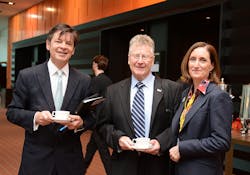Australian Summit Delivers Global ITS Update
Congestion and safety emerged as key themes at the 2015 ITS Australia Summit and National Electronic Tolling Forum held in Melbourne Australia recently with discussion focused on gaining greater value from existing infrastructure and planning for automated driving.
The event also attracted significant media attention with the message to the news outlets that ITS technologies will make transport safer, more sustainable and more efficient.
Opened by the Victorian Minister for Roads and Road Safety Luke Donnellan, the event welcomed 420 plus delegates from Australia and overseas. Minister Donnellan said Victorians made 14 million trips each day by road – using vehicles, bicycles or walking – or by rail on trains or trams.
He said better use must be made of current infrastructure by using ITS solutions to move more people and freight. The Minister emphasised that public transport and intelligent cars are priorities and that Victoria is looking at a future with driverless cars.
ITS Australia Chief Executive Officer Susan Harris outlined the urgent need for establishing and regularly publishing recognised measures for congestion in our cities. “We must encourage a focus on congestion management and the benefits that ITS technologies deliver, in a similar way to road toll data driving our focus and commitment to road safety initiatives,” she said.
Transurban Chief Executive Officer Scott Charlton outlined the company’s recently launched trial exploring what Melbournians think about road user charging, particularly distance based charging. As a major toll road operator, Transurban believes that improved data capture and faster processing will make real time application of pricing and information to customers a reality.
Charlton said Australia’s congestion levels were challenging with capital cities Melbourne, Sydney and Brisbane suffering similar levels to New York, London, Shanghai and Rome. He anticipates that driverless vehicles will be in widespread use within five to 10 years with mass adoption by 2040.
A facilitator of the steady move to autonomous vehicles is Director of the Michigan Mobility Transformation Centre (MTC) and Director of the University of Michigan Transportation Research Institute (UMTRI) Peter Sweatman, who presented a number of papers at the Summit.
He foresees a changing scope of organisations involved in transportation as private technology companies take leadership in finding solutions around issues such as managing big data and cyber security issues.
Peter Sweatman, who is Australian, said he is relinquishing the UMTRI directorship to focus on the MTC Ann Arbor Michigan automated vehicle project. The MTC is developing three complementary on-road vehicle deployments in Ann Arbor and across southeast Michigan.
ITS Japan President Hajime Amano emphasised the value of improving existing infrastructure with his report on the 60% reduction in rear end traffic accidents resulting from the installation of road congestion ahead warnings to drivers in high incident areas.
Amano said simple messages communicated directly to relevant drivers at the relevant time has improved safety and improved mobility, because fewer accidents means traffic keeps moving forward.
Ygomi Chair T Russell Shields encouraged developers to consider mobile phone based Long Term Evolution (LTE) wireless communication in the drive toward connected vehicles as a solution rather than place all bets on the contested 5.9 GHz dedicated short range frequency.
Xerox Director of Communications and Marketing Richard Harris presented a Los Angeles case study proving the benefits of human behaviour change based on pricing. A mobile phone app alerting city drivers to vacant car parks that had variable fee rates higher during peak times delivered two positive outcomes:
- There was a 10 percent reduction in traffic circulating in search of a car park.
- Revenue on the selected parking spaces increased by 2 percent.
Another speaker to bring the infrastructure and automated vehicle message home was chassis engineering general manager of Robert Bosch Australia Carl Liersch. Through his video presentation, we learned how many of the technologies required for automated vehicles are already in use on our roads.
He said it is only a matter of time and Bosch recommends a stepped approach to full automation over the next 10 years. To ensure the integrity of automated driving, the vehicle systems now available must be refined and integrated with other mobility systems beyond the vehicle – connecting the vehicle to the infrastructure and to other vehicles.
International technology showcase
Harris said the 2015 ITS Australia Summit and NeTC event was a mini international showcase of ITS technologies. “We were privileged to have with us in Melbourne 50 international delegates,” she said.
“This included senior ITS industry leaders from New Zealand (11), USA (9), Taiwan (4), Norway (4), Sweden (3), China (3), France (3), UK (2) and one delegate from each of Belgium, Canada, Germany, India, Italy, Japan, Nigeria, and Spain.
“Some among this international group are members of the ITS World Congress Board of Directors. We hosted World Congress Board members before the Summit and NeTC Forum for a tour of the 23rd World Congress facilities that the world’s most liveable city – Melbourne – has to offer.
“The facilities we have under a single roof to host the 2016 ITS World Congress, Exhibition and Technical tours for 7000-plus delegates are world’s best practice. Indeed we had to assure one visiting World Congress Board member that the cost of attending the 23rd World Congress in our brilliant Melbourne Convention and Exhibition Centre will be comparable to prices for recent World Congresses.
“The 2015 Summit and NeTC provided a small preview of what international and Australia guests can expect when ITS Australia hosts the ITS World Congress in Melbourne in October 2016".




